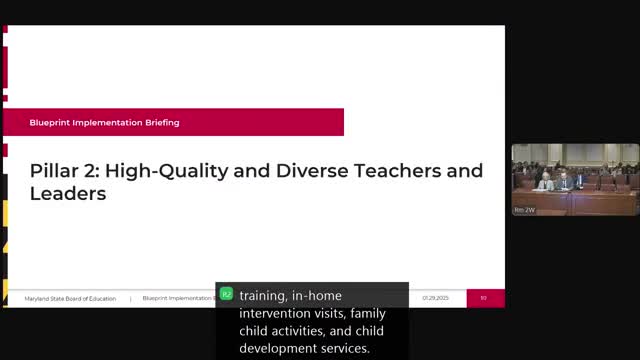Maryland commits to teacher development with 10% salary increases and new certification programs
January 29, 2025 | Education, Energy, and the Environment Committee, SENATE, SENATE, Committees, Legislative, Maryland
This article was created by AI summarizing key points discussed. AI makes mistakes, so for full details and context, please refer to the video of the full meeting. Please report any errors so we can fix them. Report an error »

In a recent meeting held on January 29, 2025, Maryland's Education, Employment, and Economic (EEE) Committee focused on significant advancements in teacher development and compensation, marking a pivotal moment for educators across the state. The atmosphere was charged with optimism as committee members discussed the strides made in elevating the teaching profession, particularly through salary increases and professional development initiatives.
All 24 Local Education Agencies (LEAs) have confirmed a minimum 10% salary increase for teachers from 2019 to 2024, with a goal of establishing a base starting salary of $60,000 by 2026. This commitment reflects a broader effort to attract and retain quality educators in Maryland's public schools. In fiscal year 2025, the Maryland State Department of Education (MSDE) allocated $783,000 to support training for national board certification candidates, further enhancing the professional landscape for teachers.
The meeting highlighted a notable achievement: over 1,000 teachers earned their national board certification in December 2024, bringing the total to 2,279 certified educators statewide. However, the committee acknowledged that while progress has been made, challenges remain. Only 12% of nationally board certified teachers are in low-performing schools, and the representation of educators of color still falls short of reflecting the diversity of the student population.
The discussion also addressed the ongoing educator shortage, with a current vacancy rate of 1,600 positions. The rise of conditionally licensed teachers—now over 6,000—has become a pressing issue, as many classrooms are staffed by substitutes or unlicensed educators. The committee emphasized the importance of supporting these teachers, particularly those from communities of color, to foster leadership and improve student outcomes in high-poverty areas.
Despite an increase in enrollment in educator preparation programs since 2016, the output of graduates has not kept pace with demand. The committee noted that Maryland continues to rely on importing teachers from other states, but this supply is dwindling. To address the shortage, the focus must shift to licensing the existing pool of conditionally certified educators and enhancing collaborative time for professional development.
As the meeting concluded, the committee underscored the need for innovative solutions, such as "grow your own" teacher preparation programs, which aim to recruit and train local candidates. These initiatives are designed to strengthen the connection between educators and their communities, ultimately enhancing the educational experience for students.
The discussions at this meeting reflect a critical moment for Maryland's education system, as leaders work to navigate the complexities of teacher recruitment and retention while striving to fulfill the promises of the Blueprint for Maryland's Future. The path ahead is challenging, but the commitment to improving the teaching profession remains steadfast.
All 24 Local Education Agencies (LEAs) have confirmed a minimum 10% salary increase for teachers from 2019 to 2024, with a goal of establishing a base starting salary of $60,000 by 2026. This commitment reflects a broader effort to attract and retain quality educators in Maryland's public schools. In fiscal year 2025, the Maryland State Department of Education (MSDE) allocated $783,000 to support training for national board certification candidates, further enhancing the professional landscape for teachers.
The meeting highlighted a notable achievement: over 1,000 teachers earned their national board certification in December 2024, bringing the total to 2,279 certified educators statewide. However, the committee acknowledged that while progress has been made, challenges remain. Only 12% of nationally board certified teachers are in low-performing schools, and the representation of educators of color still falls short of reflecting the diversity of the student population.
The discussion also addressed the ongoing educator shortage, with a current vacancy rate of 1,600 positions. The rise of conditionally licensed teachers—now over 6,000—has become a pressing issue, as many classrooms are staffed by substitutes or unlicensed educators. The committee emphasized the importance of supporting these teachers, particularly those from communities of color, to foster leadership and improve student outcomes in high-poverty areas.
Despite an increase in enrollment in educator preparation programs since 2016, the output of graduates has not kept pace with demand. The committee noted that Maryland continues to rely on importing teachers from other states, but this supply is dwindling. To address the shortage, the focus must shift to licensing the existing pool of conditionally certified educators and enhancing collaborative time for professional development.
As the meeting concluded, the committee underscored the need for innovative solutions, such as "grow your own" teacher preparation programs, which aim to recruit and train local candidates. These initiatives are designed to strengthen the connection between educators and their communities, ultimately enhancing the educational experience for students.
The discussions at this meeting reflect a critical moment for Maryland's education system, as leaders work to navigate the complexities of teacher recruitment and retention while striving to fulfill the promises of the Blueprint for Maryland's Future. The path ahead is challenging, but the commitment to improving the teaching profession remains steadfast.
View full meeting
This article is based on a recent meeting—watch the full video and explore the complete transcript for deeper insights into the discussion.
View full meeting
